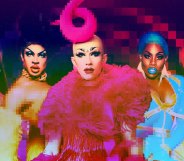Gay gamers experience Second Life

Video games may come in many shapes and sizes, but one thing tends to stay the same from game to game: They all give the people playing them the opportunity to step into someone else’s shoes.
As thrilling as that sounds in theory, in practice it usually forces gamers to take control of characters that look little like them and move them through storylines over which they have little control.
A few fairly recent releases have added some breathing room to that often claustrophobic aspect of video gaming by letting players alter their virtual selves and experiences as they see fit.
One of the first and most famous examples of this more accessible breed of video game is The Sims.
This “digital dollhouse,” as creator Will Wright calls it, has racked up sales of more than 70 million units since its release in 2000.
A more recent and advanced example is Second Life , the Internet-based virtual world launched in 2003 by Linden Research.
Like The Sims, Second Life gives players free rein to create the character of their dreams: If they want to make mirror images of themselves, they can; and if they’d like to remake themselves as Greek Adonises or Pagan goddesses, they can do that, too.
That’s where the similarities end, however. In The Sims, players have limited control over their creations once they’ve been let loose on the virtual world.
In Second Life on the other hand players are given complete control over their virtual experience.
They can walk, run or fly around the game’s locales, some of which are based on real-world counterparts such as Provincetown or entertainment fantasy lands such as The L Word’s West Hollywood, meet and socialise with other ‘residents’ and create and trade items and services with their new friends and neighbours.
Second Life’s social aspects have attracted the attention of a lot of people in the four years since its release. In fact, more than 8.9 million accounts are thought to have been created in that time.
One of those was created by Georgetown University grad student Donald Jones, who was introduced to the game a few years ago by one of his professors.
“As a gay man who grew up during the computer age, I learned a lot about what it is to be gay on line,” says the Ohio native.
“The Internet is where I first met other gay people after I came out in the mid 90s.
As years have gone on, I’ve continued to use the Internet to connect with and meet other gay people.”
Jones’ initial outings in Second Life reminded him of the early experiences he had on line as gay man.
“It was interesting to see other gay people interacting with each other,” he says.
Even more interesting was how LGBT individuals and groups created virtual bodies and spaces within the game’s environment.
That interest quickly led to Jones tackling the topic in his recently completed Master of Arts thesis, Queered Virtuality: The claiming and making of queer spaces and bodies in the user-constructed synthetic world of Second Life.
Jones first got down to business in late 2005.
“I started by completing an initial analysis about what some of these ‘queer spaces’ look like,” he explains. He also conducted a series of interviews with GLBT residents of Second Life in early 2006.
“I deployed a survey at that time as well,” Jones says.
About 350 people completed the survey, while more than 20 agreed to be interviewed.
“We sat on the couch inside my lighthouse in Second Life and talked about what Second Life meant to them as a gay person as well as what gay space within that virtual world meant to them,” Jones says.
“That certainly led to some interesting conversations,” he adds.
“A few years ago, for instance, I was standing in Provincetown (in Second Life ) and this guy approached me.
“He was trying to pick me up, actually, which is one of the funny things about Second Life : People will try to pick you up because they think your avatar is ‘hot.’
“I told him I was a grad student and what I was doing in Second Life (I don’t keep much of a separation between my real-life self and my Second Life self) and he told me he was from Singapore, married, Catholic and that he feels he can’t in any way express his gay feelings in real life,” Jones recalls.
“He told me he loves his wife and feels a lot of social pressure to maintain his current life, so he uses Second Life to explore this part of his identity that he can’t explore in the real world.”
Another interesting conversation occurred between Jones and a Midwestern man who shared that when he first ventured into Second Life, he considered himself a straight man who liked to dress in women’s clothing every so often.
“He went into Second Life and played as a woman,” Jones says.
“As he did this more and more and saw himself reflected back as a woman, and experienced people interacting with him as a woman, he realised he was in fact transgendered.”
The man eventually altered his avatar to look much like he would as a woman, taller and bulkier, if he transitioned.
“The language he used was wonderful: ‘I love having a vagina,'” Jones remembers.
“For him it was a profound experience to see himself as a woman and to interact with other people within Second Life as a woman.”
Yet another person Jones came across in his research was a young Texan attending a conservative college in Pennsylvania.
“For the last three years he has portrayed himself in Second Life as a gay male,” Jones says.
“In real life, he has moved from thinking he was completely straight to being questioning. He has even become part of a gay-straight alliance on his campus.
“He attributes part of his transformation to the experiences he’s had within Second Life.
“Interacting with and getting to know gay people within the game has opened his eyes.”
Jones admits these are some of the more profound experiences people shared with him while researching his thesis.
“I also encountered plenty of gay people within Second Life who were just there to play around,” he says.
“And there were plenty of straight people ‘playing’ gay as well.”
Although Jones found that 20 percent of the LGBT residents he interviewed have experienced some form of homophobia within Second Life, overall he believes the virtual world is a welcoming place.
“The 20 percent who say they’ve experienced some form of homophobia sounds startling, but what else would you expect when you open up a space to anyone in the world? You get a lot of conflicting ideas about people and society, particularly around sexuality,” Jones says.
“That said, people within Second Life generally are ‘live and let live’ kind of people.”
Although gamer Terry Campbell has experienced a few of what he calls “breeder attacks” while exploring Second Life – “one time, someone who had made himself look like a penis went around ramming himself into other guys for attention,” he says of the incident, which ended with angry gamers using ‘hate speech’ – his overall view of the game is positive.
“I included in my profile that I’m gay, but no one has approached me about it,” Campbell says before adding: “Second Life really is no more a reflection of the Internet than the Internet is a reflection of real life.”
Bryan Ochalla © 2007 GayWired.com; All Rights Reserved.

